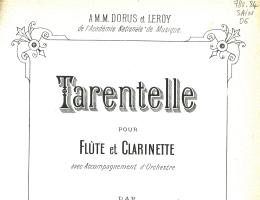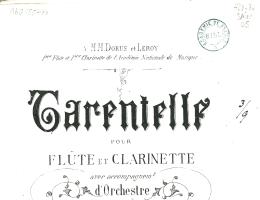Tarantelle for flute and clarinet op. 6
With orchestral or piano accompaniment
In 1857, the year of his appointment as organist at La Madeleine, the young Camille Saint-Saëns was able to savour his success and forget his failure at the Prix de Rome in 1852. These early opus numbers reveal his interest in salon pieces, sacred works and symphonic concerts. With his Tarentelle op. 6, he entered the realm of the concerto by tailoring a piece for his two dedicatees: Louis Dorus and Adolphe Leroy, respectively first flute and first clarinet at the Académie Royale de Musique. Saint-Saëns, who had been giving concerts himself since 1846, had probably already had the opportunity to rub shoulders with these two virtuosos at Parisian soirées. He was at the piano to accompany the two soloists on the evening of the premiere, on 28 April 1857, at the Salle Pleyel. Enticing, ever-changing, the piece offers a wide range of colours, from its playful beginning to its precipitous end, via a relaxed, expressive central section. A simple four-bar motive, stated by the piano in the introduction, serves as a common thread throughout the cheerful piece. In 1911, in an article on Rossini for L'Écho de Paris, Saint-Saëns recounted how, at one of his parties, he himself played the Tarantelle while pretending he had written it. Once the audience had expressed their enthusiasm, he reportedly said to them, “I agree entirely with your opinion; but this duet is not by me, it is by Monsieur, here”. By jokingly passing the baton to his younger colleague, he introduced him into the world of dilettantes.


